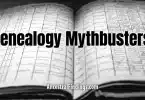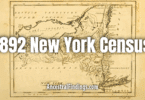Released to the public for research in April of 2002, the 1930 US federal census is a common tool for most genealogists. Many have used it more than once, and continue to go back to it to research additional ancestors, or to find out about the early years of living family members. It is a valuable genealogical resource. However, no matter how many times one has perused it, there are still hidden secrets to be found in this census that can give up old family secrets, provide brand new information, and/or point the way to additional research sources.
If you are using or want to use the 1930 US census in your genealogy research, here are some tips to mine it for every drop of genealogical gold it contains. You might be surprised at some of the things you missed, even if you have used it numerous times. Here’s what to look for and how to use it in your research.
Understand that Times was Changing
When planning for the upcoming 1930 federal census, those at the Census Bureau were concerned that the US population was approaching a point where it would be too difficult to obtain all of the information on a census that used to be obtained.
A census that asked all of the traditional questions, plus new ones the officials wanted to ask on the 1930 census would be too large and unwieldy for census takers to use, or analysts to tabulate. Therefore, the 1930 census is the last one to ask traditional questions such as language spoken, employment status, and veteran status. In fact, the 1930 census is considered to be the last of the “traditional” censuses. It is similar to the 1920 census in content, but there are some important changes on it, as well.

1930 US Census Blank Form (National Archives)
Consumer Trends were Important
New inventions were beginning to be widely adopted in the early 20th century, and the government wanted to know who was using them. In particular, this census is the only one to ask households if they owned a radio) “radio set,” as worded on the census). The radio was viewed by government officials as a sign of consumer confidence in the economy, as well as a valuable medium for advertising consumer goods to encourage shopping.
In keeping with keeping track of current economic trends, this census was the first to recognize that more women were entering the workforce. So, it is the first census to designate one household member as a “homemaker,” if one, in fact, lived in the home. This inclusion and its wording showed that the word “homemaker” meant something new in modern America. Girls were then taking Home Economics classes in high school (sometimes called “domestic science”). This demonstrated that homemaking skills were now considered a valuable economic resource, not just something that was expected of all women to do. Advertisers were even showing homemaking as a profession to try to attract the interest of female shoppers.
Modified Marriage Questions
This census changed the questions regarding marriage just a bit from what they used to be. This census asks for the age of each respondent at their first marriage, not their current one. This was because the government believed the national age at first marriage to be rising, and they wanted to confirm it. They also wanted to try to determine the reason why ten percent more women reported being married between the ages of fifteen and twenty-five on the 1920 census than on the 1900 census.
Housing Questions
The 1930 census was concerned with analyzing social trends using what were considered scientific methods. One way it did this was by asking the value of the home owned by a respondent, or how much a month they paid in rent if they did not own their home. It was hoped that by asking this question, areas of poverty in the country could be identified and rectified. At the very least, it was hoped the reasons for certain areas being poorer or richer than others would be revealed by this question. The economic levels of different neighborhoods within the same region or area could also be revealed with this question.
Questions Regarding Race
A person’s race was always a census question. However, the census enumerators for the 1930 census were given instructions regarding recording the answers to this question that reflected the contemporary views of race and racial hierarchy of the time. As an example, if someone reported having both white and African-American ancestry, they were to be reported as being African-American regardless of how small a percentage of African-American ancestry they had, and whether or not they looked white or lived as a white person in a white community.
However, when it came to Native American ancestry, 1930 census enumerators were instructed to list someone of mixed Native American and African-American ancestry as whichever ancestry predominated, or which race the person lived as and was accepted as in their community. The same thing went for people reporting mixed Native American and white ancestry. Anyone born in Mexico or whose parents were born in Mexico was to be listed as Mexican (as opposed to the 1940 census, where Mexican-born people were to be listed as white).
Immigration and Unemployment
The 1930 census asked if a person was an American by birth or, if foreign-born, a naturalized citizen. It did not ask the year of immigration, as past censuses had done. This reflected the sharp decline in immigration to the United States after WWI. Immigration just was not that important to the government anymore for the 1930 census.
This census also asked whether a person had worked the day prior to being enumerated. This question was planned before the stock market crash the year prior, and it was designed to give a picture of the employment and unemployment rate in the country. It was expected to paint a rosy picture, but by the time the census was taken, unemployment was pretty high.
All of these questions can tell you a lot more about your ancestors and their lives during the early 20th century, during a period when things in the United States were changing, including racial relations, gender roles, economics, immigration, and the family. Some of the answers may also point you to additional record resources you can use to find even more information on your ancestors of the 1930 census.






